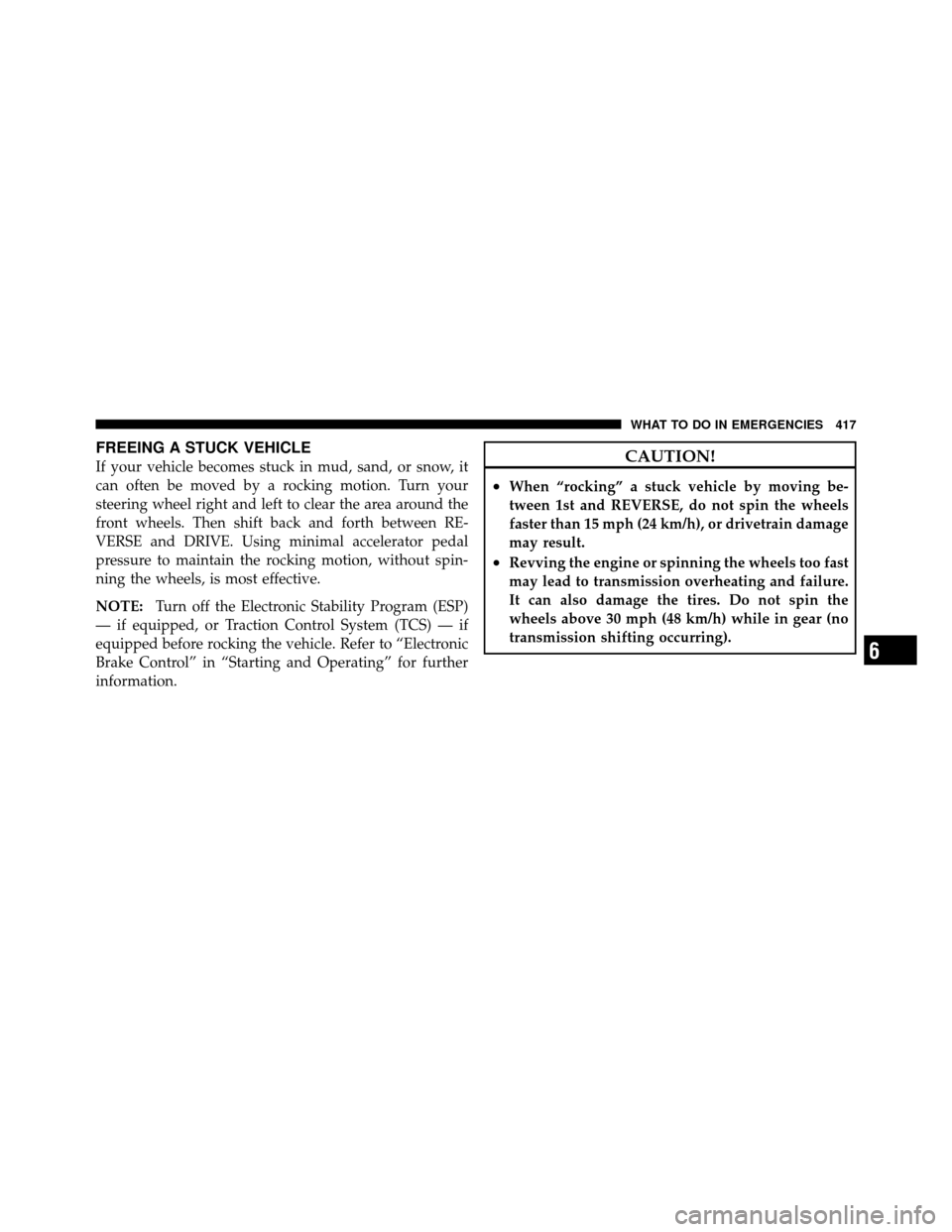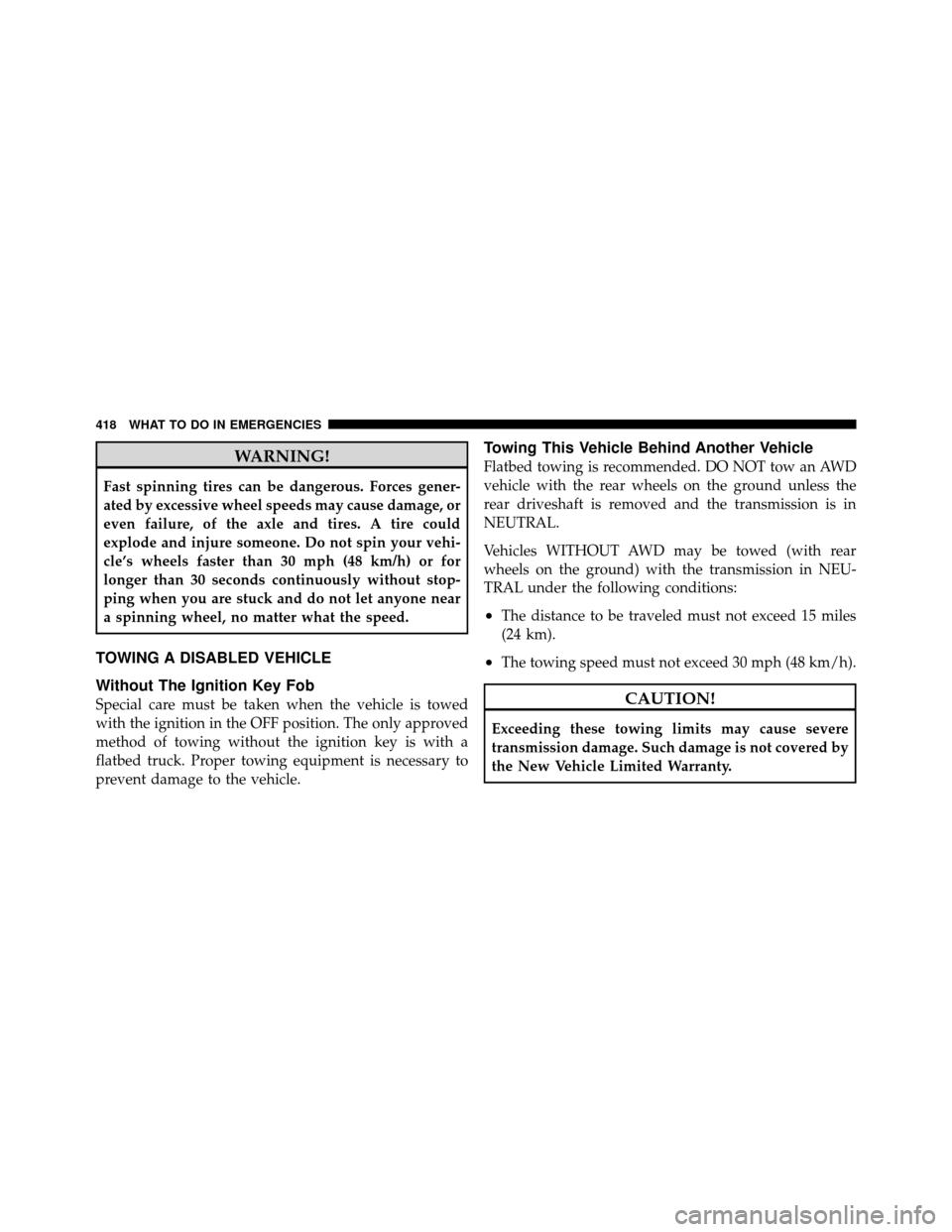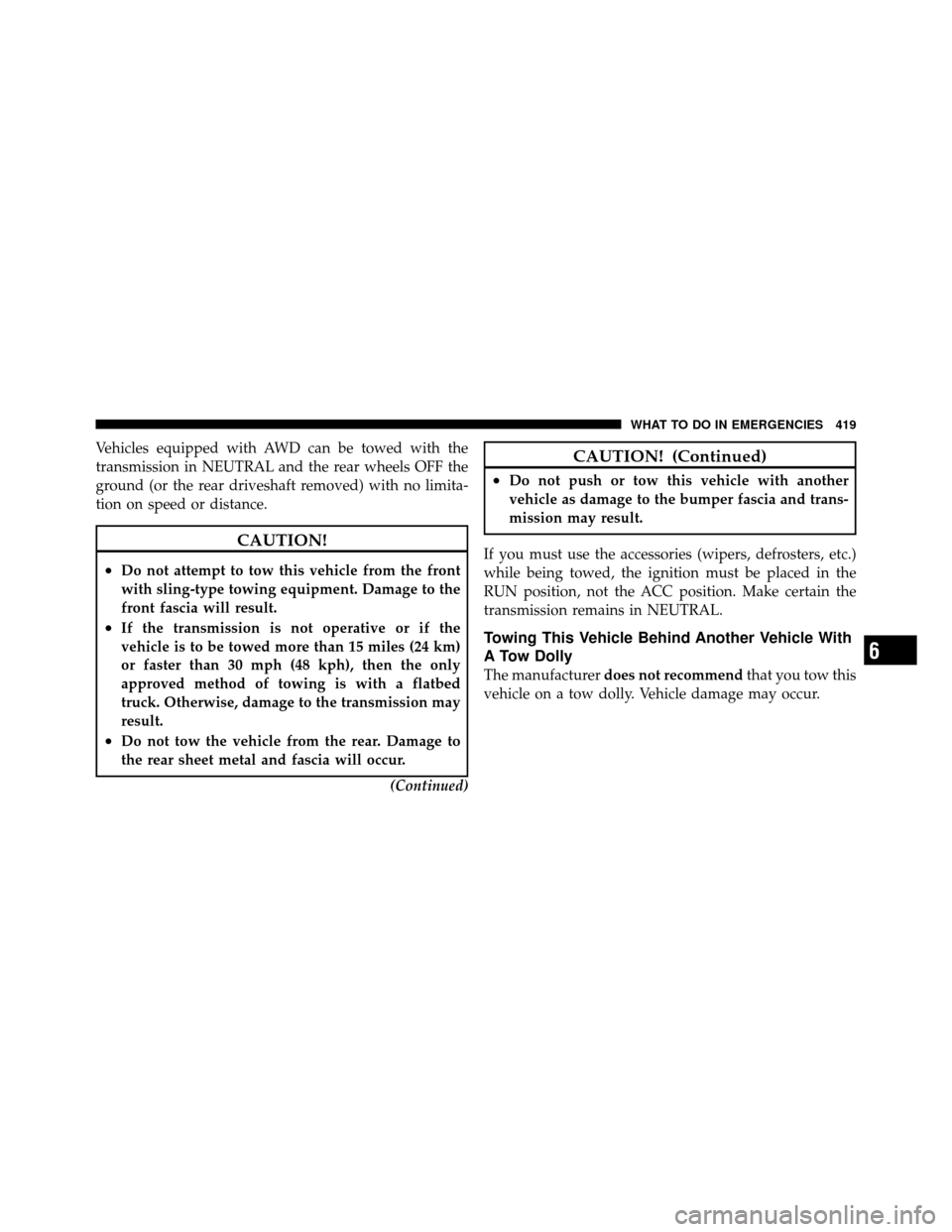Page 398 of 538
WARNING!
If the driveshaft is removed, the vehicle can roll even
if the transmission is in PARK, which could cause
serious injury or death.
The parking brake must be firmly engaged and the
wheels chocked during driveshaft removal and installa-
tion. The parking brake must remain engaged unless the
vehicle is securely and properly connected to the tow
vehicle, or the driveshaft is completely reinstalled. See
your authorized dealer for proper driveshaft removal
and reinstallation procedures, including flange
orientation/alignment, use of thread-locking compound,
proper bolt torque specifications, etc.
CAUTION!
Towing this vehicle in violation of the above require-
ments can cause severe transmission and/or transfer
case damage. Such damage is not covered by the New
Vehicle Limited Warranty.
5
STARTING AND OPERATING 397
Page 401 of 538

HAZARD WARNING FLASHER
The Hazard Warning flasher switch is located in the
center of the instrument panel between the center air
outlets.Press the switch to turn on the Hazard Warning
flasher. When the switch is activated, all directional
turn signals will flash on and off to warn oncoming
traffic of an emergency. Press the switch a second time to
turn off the Hazard Warning flasher.
This is an emergency warning system and it should not
be used when the vehicle is in motion. Use it when your
vehicle is disabled and it is creating a safety hazard for
other motorists.
When you must leave the vehicle to seek assistance, the
Hazard Warning flasher will continue to operate even
though the ignition is placed in the OFF position. NOTE:
With extended use the Hazard Warning flasher
may wear down your battery.
IF YOUR ENGINE OVERHEATS
In any of the following situations, you can reduce the
potential for overheating by taking the appropriate ac-
tion.
•On the highways — slow down.
•In city traffic — while stopped, place the transmission
in NEUTRAL, but do not increase the engine idle
speed.
NOTE: There are steps that you can take to slow down
an impending overheat condition:
•If your air conditioner (A/C) is on, turn it off. The A/C
system adds heat to the engine cooling system and
turning the A/C off can help remove this heat.
400 WHAT TO DO IN EMERGENCIES
Page 406 of 538
WARNING! (Continued)
•Always park on a firm, level surface as far from
the edge of the roadway as possible before raising
the vehicle.
•Block the wheel diagonally opposite the wheel to
be raised.
•Set the parking brake firmly and set an automatic
transmission in PARK; a manual transmission in
REVERSE.
•Never start or run the engine with the vehicle on a
jack.
•Do not let anyone sit in the vehicle when it is on a
jack.
•Do not get under the vehicle when it is on a jack.
•Only use the jack in the positions indicated and
for lifting this vehicle during a tire change.(Continued)
WARNING! (Continued)
•If working on or near a roadway, be extremely
careful of motor traffic.
•To assure that spare tires, flat or inflated, are
securely stowed, spares must be stowed with the
valve stem facing the ground.
•Turn on the Hazard Warning flasher.
1. Remove the spare tire, jack, and lug wrench.
Jack Warning Label
6
WHAT TO DO IN EMERGENCIES 405
Page 415 of 538
Remote Battery Posts
WARNING!
•Take care to avoid the radiator cooling fan when-
ever the hood is raised. It can start anytime the
ignition switch is on. You can be injured by
moving fan blades.
•Remove any metal jewelry such as watch bands or
bracelets that might make an inadvertent electrical
contact. You could be seriously injured.
•Batteries contain sulfuric acid that can burn your
skin or eyes and generate hydrogen gas which is
flammable and explosive. Keep open flames or
sparks away from the battery.
1. Set the parking brake, shift the automatic transmission
into PARK and turn the ignition to LOCK.
1 — Remote Negative (-)Post
2 — Remote Positive (+)Post
414 WHAT TO DO IN EMERGENCIES
Page 418 of 538

FREEING A STUCK VEHICLE
If your vehicle becomes stuck in mud, sand, or snow, it
can often be moved by a rocking motion. Turn your
steering wheel right and left to clear the area around the
front wheels. Then shift back and forth between RE-
VERSE and DRIVE. Using minimal accelerator pedal
pressure to maintain the rocking motion, without spin-
ning the wheels, is most effective.
NOTE:Turn off the Electronic Stability Program (ESP)
— if equipped, or Traction Control System (TCS) — if
equipped before rocking the vehicle. Refer to “Electronic
Brake Control” in “Starting and Operating” for further
information.CAUTION!
•When “rocking” a stuck vehicle by moving be-
tween 1st and REVERSE, do not spin the wheels
faster than 15 mph (24 km/h), or drivetrain damage
may result.
•Revving the engine or spinning the wheels too fast
may lead to transmission overheating and failure.
It can also damage the tires. Do not spin the
wheels above 30 mph (48 km/h) while in gear (no
transmission shifting occurring).
6
WHAT TO DO IN EMERGENCIES 417
Page 419 of 538

WARNING!
Fast spinning tires can be dangerous. Forces gener-
ated by excessive wheel speeds may cause damage, or
even failure, of the axle and tires. A tire could
explode and injure someone. Do not spin your vehi-
cle’s wheels faster than 30 mph (48 km/h) or for
longer than 30 seconds continuously without stop-
ping when you are stuck and do not let anyone near
a spinning wheel, no matter what the speed.
TOWING A DISABLED VEHICLE
Without The Ignition Key Fob
Special care must be taken when the vehicle is towed
with the ignition in the OFF position. The only approved
method of towing without the ignition key is with a
flatbed truck. Proper towing equipment is necessary to
prevent damage to the vehicle.
Towing This Vehicle Behind Another Vehicle
Flatbed towing is recommended. DO NOT tow an AWD
vehicle with the rear wheels on the ground unless the
rear driveshaft is removed and the transmission is in
NEUTRAL.
Vehicles WITHOUT AWD may be towed (with rear
wheels on the ground) with the transmission in NEU-
TRAL under the following conditions:
•The distance to be traveled must not exceed 15 miles
(24 km).
•The towing speed must not exceed 30 mph (48 km/h).
CAUTION!
Exceeding these towing limits may cause severe
transmission damage. Such damage is not covered by
the New Vehicle Limited Warranty.
418 WHAT TO DO IN EMERGENCIES
Page 420 of 538

Vehicles equipped with AWD can be towed with the
transmission in NEUTRAL and the rear wheels OFF the
ground (or the rear driveshaft removed) with no limita-
tion on speed or distance.
CAUTION!
•Do not attempt to tow this vehicle from the front
with sling-type towing equipment. Damage to the
front fascia will result.
•If the transmission is not operative or if the
vehicle is to be towed more than 15 miles (24 km)
or faster than 30 mph (48 kph), then the only
approved method of towing is with a flatbed
truck. Otherwise, damage to the transmission may
result.
•Do not tow the vehicle from the rear. Damage to
the rear sheet metal and fascia will occur.(Continued)
CAUTION! (Continued)
•Do not push or tow this vehicle with another
vehicle as damage to the bumper fascia and trans-
mission may result.
If you must use the accessories (wipers, defrosters, etc.)
while being towed, the ignition must be placed in the
RUN position, not the ACC position. Make certain the
transmission remains in NEUTRAL.
Towing This Vehicle Behind Another Vehicle With
A Tow Dolly
The manufacturer does not recommend that you tow this
vehicle on a tow dolly. Vehicle damage may occur.
6
WHAT TO DO IN EMERGENCIES 419
Page 423 of 538

▫Adding Washer Fluid ................. 440
▫ Exhaust System ..................... 441
▫ Cooling System ..................... 444
▫ Brake System ....................... 449
▫ Automatic Transmission ............... 452
▫ All Wheel Drive (AWD) – If Equipped ..... 454
▫ Rear Axle .......................... 454
▫ Appearance Care And Protection From
Corrosion .......................... 455
� Fuses .............................. 460
▫ Integrated Power Module .............. 460
▫ Rear Power Distribution Center .......... 463
� Vehicle Storage ....................... 468
� Replacement Bulbs .................... 468 �
Bulb Replacement ..................... 470
▫ Low Beam Headlamp, High Beam
Headlamp, Park/Turn Lamp, Inner Park
Lamp, And Outer Park Lamp – 300 Models . . 470
▫ Low Beam Headlamp, High Beam
Headlamp, And Park/Turn Lamp – 300C . . . 472
▫ Backup Lamp, Side Marker Lamp, And
Tail/Stop Turn Lamp — 300 Models ....... 472
▫ Tail/Stop, Tail, Turn Signal Lamp, And
Backup Lamp — 300C Models ........... 476
▫ License Lamp ....................... 479
� Fluid Capacities ...................... 480
� Fluids, Lubricants, And Genuine Parts ....... 482
▫ Engine ............................ 482
▫ Chassis ........................... 483
422 MAINTAINING YOUR VEHICLE